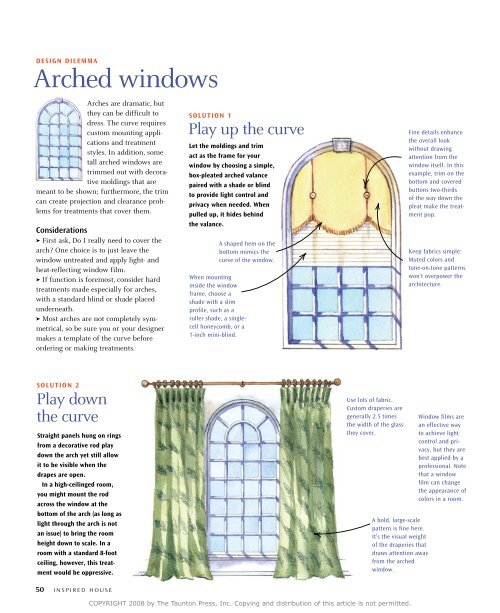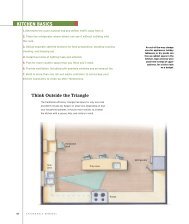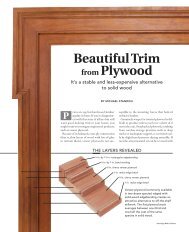Treatments for Problem Windows - Fine Homebuilding
Treatments for Problem Windows - Fine Homebuilding
Treatments for Problem Windows - Fine Homebuilding
Create successful ePaper yourself
Turn your PDF publications into a flip-book with our unique Google optimized e-Paper software.
Design Dilemma<br />
Arched windows<br />
Arches are dramatic, but<br />
they can be difficult to<br />
dress. The curve requires<br />
custom mounting applications<br />
and treatment<br />
styles. In addition, some<br />
tall arched windows are<br />
trimmed out with decorative<br />
moldings that are<br />
meant to be shown; furthermore, the trim<br />
can create projection and clearance problems<br />
<strong>for</strong> treatments that cover them.<br />
Considerations<br />
➤ First ask, Do I really need to cover the<br />
arch? One choice is to just leave the<br />
window untreated and apply light- and<br />
heat-reflecting window film.<br />
➤ If function is <strong>for</strong>emost, consider hard<br />
treatments made especially <strong>for</strong> arches,<br />
with a standard blind or shade placed<br />
underneath.<br />
➤ Most arches are not completely symmetrical,<br />
so be sure you or your designer<br />
makes a template of the curve be<strong>for</strong>e<br />
ordering or making treatments.<br />
solution 2<br />
Play down<br />
the curve<br />
straight panels hung on rings<br />
from a decorative rod play<br />
down the arch yet still allow<br />
it to be visible when the<br />
drapes are open.<br />
in a high-ceilinged room,<br />
you might mount the rod<br />
across the window at the<br />
bottom of the arch (as long as<br />
light through the arch is not<br />
an issue) to bring the room<br />
height down to scale. in a<br />
room with a standard 8-foot<br />
ceiling, however, this treatment<br />
would be oppressive.<br />
50 i n s p i r e d h o u s e<br />
solution 1<br />
Play up the curve<br />
let the moldings and trim<br />
act as the frame <strong>for</strong> your<br />
window by choosing a simple,<br />
box-pleated arched valance<br />
paired with a shade or blind<br />
to provide light control and<br />
privacy when needed. When<br />
pulled up, it hides behind<br />
the valance.<br />
A shaped hem on the<br />
bottom mimics the<br />
curve of the window.<br />
When mounting<br />
inside the window<br />
frame, choose a<br />
shade with a slim<br />
profile, such as a<br />
roller shade, a singlecell<br />
honeycomb, or a<br />
1-inch mini-blind.<br />
Use lots of fabric.<br />
Custom draperies are<br />
generally 2.5 times<br />
the width of the glass<br />
they cover.<br />
A bold, large-scale<br />
pattern is fine here.<br />
It’s the visual weight<br />
of the draperies that<br />
draws attention away<br />
from the arched<br />
window.<br />
COPYRIGHT 2008 by The Taunton Press, Inc. Copying and distribution of this article is not permitted.<br />
<strong>Fine</strong> details enhance<br />
the overall look<br />
without drawing<br />
attention from the<br />
window itself. In this<br />
example, trim on the<br />
bottom and covered<br />
buttons two-thirds<br />
of the way down the<br />
pleat make the treatment<br />
pop.<br />
Keep fabrics simple:<br />
Muted colors and<br />
tone-on-tone patterns<br />
won’t overpower the<br />
architecture.<br />
Window films are<br />
an effective way<br />
to achieve light<br />
control and privacy,<br />
but they are<br />
best applied by a<br />
professional. Note<br />
that a window<br />
film can change<br />
the appearance of<br />
colors in a room.

















